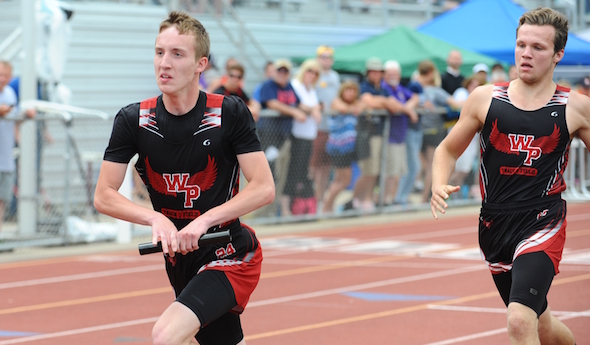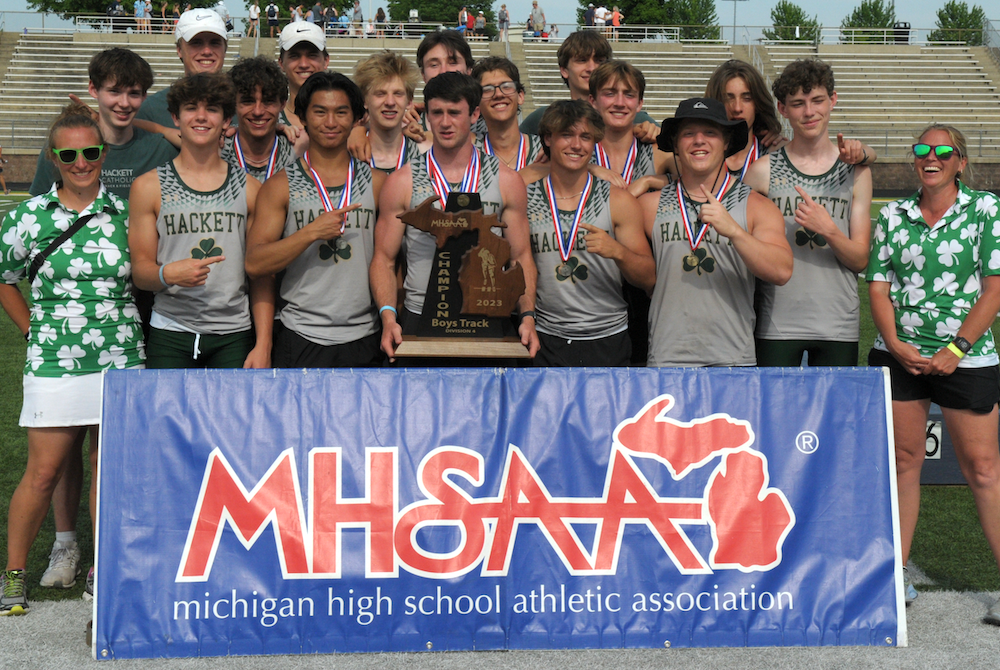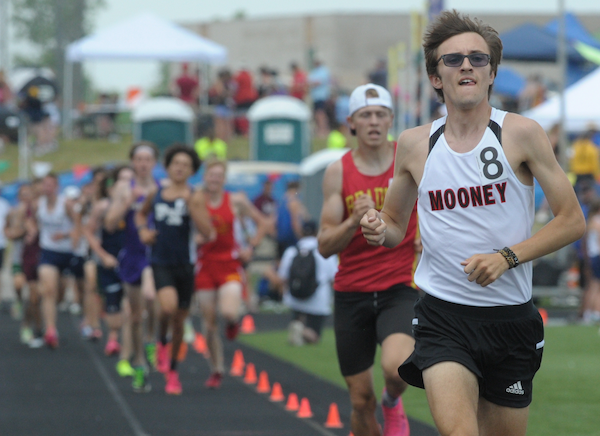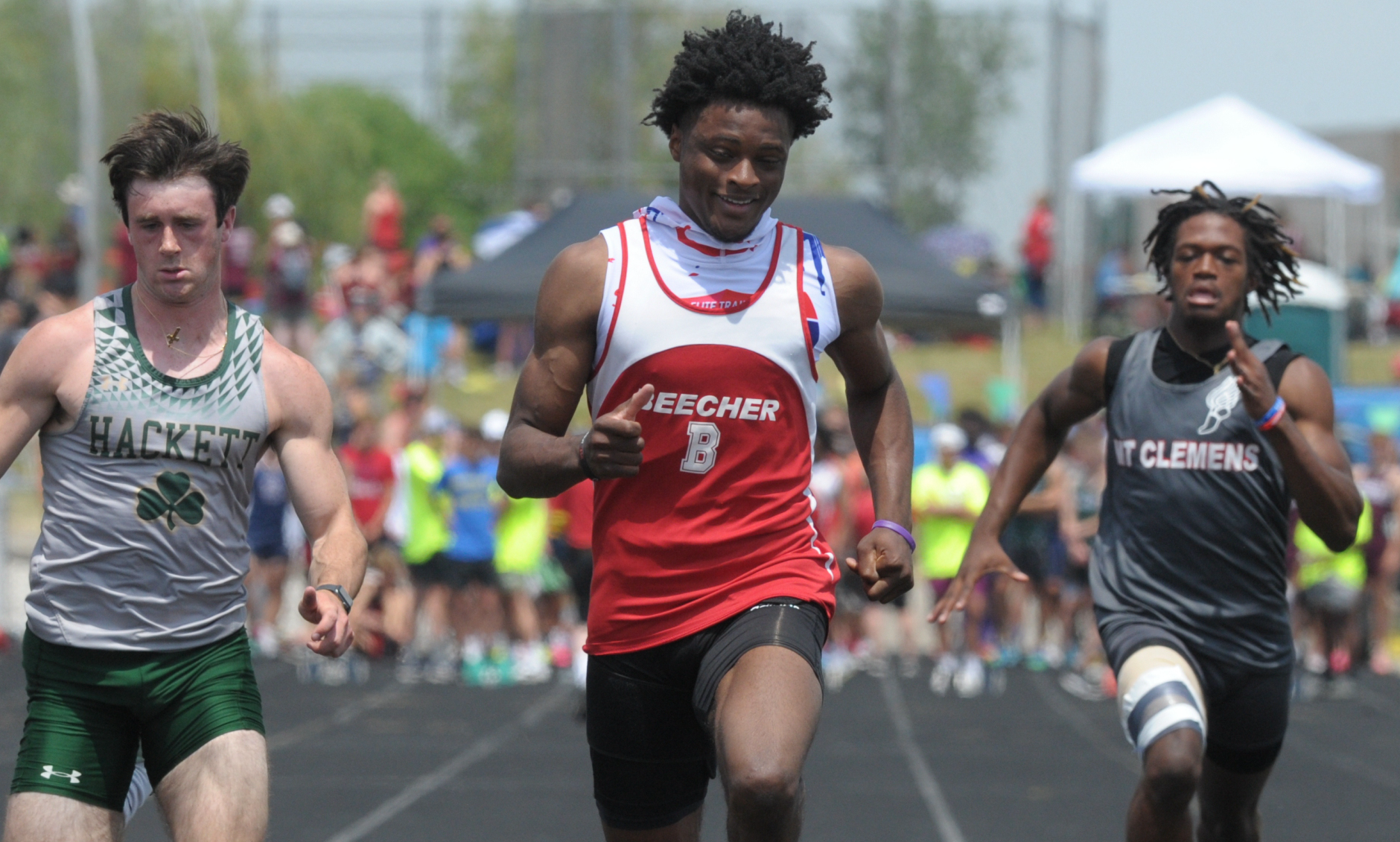
Whittemore-Prescott Gets Win That Counts Most
By
Wes Morgan
Special for MHSAA.com
June 3, 2017
GRAND RAPIDS – Winning it all doesn’t necessarily mean winning them all when it comes to track & field.
In fact, the Whittemore-Prescott boys team didn’t win a single event at Saturday’s Lower Peninsula Division 4 championship meet at Grand Rapids’ Houseman Field.
The Cardinals still managed to rack up 36 points for the team title to hold off Manton (31), Harbor Springs (28) and two other schools that finished within 10 of the lead.
Seniors Ian Driscoll and Azaiyah Bell, sophomore Ridge Schutte and junior Bradley Lomason had one of the best finishes of the day for the Cardinals, clocking in at 3 minutes, 27.98 seconds in the 1,600-meter relay for second place. Junior Michael Eagan was also runner-up after he sailed 20 feet, 10½ inches in the long jump.
The top eight finishers in each event secure all-state status from the coaches association, and Whittemore-Prescott boasted five more all-state performances. Bell took fifth in the 100 (11.50), Driscoll, Schutte, Lomason and Bell were third in the 800 relay (1:32.92) and Lomason crossed the line in sixth in the 400 (51.52).
Senior Hunter Kensa added a seventh-place effort in the 800 with a time of 2:02.04, and junior Zane Aldrich was fourth in the 3,200 (10:04.19).
No records were broken at Houseman Field on a day with perfect weather. There were, however, a handful of double champions.
Harbor Springs sophomore Jeremy Kloss swept the 1,600 and the 3,200 with times of 4:25.73 and 9:46.25, respectively. He was fueled by a runner-up finish this past fall at the Cross Country Finals, but his game plan for both races seemed to have been scrapped immediately. Kloss reacted well to the chaos that often can accompany the pressure-packed championship meet.
“In the mile, I went out a little harder than I would normally because I didn’t want to get pulled in and surrounded by a pack,” Kloss said. “So I led the race the whole time.
 “In the two mile I went out a little slow (4:57) and I was maybe in 10th place at the mile mark. I made up a lot of ground and caught the Saginaw Nouvel kid around the 300-meter mark. It was a completely different race, but it totally worked out in the end. I wanted to redeem myself during track, and it feels really nice. I was really happy.”
“In the two mile I went out a little slow (4:57) and I was maybe in 10th place at the mile mark. I made up a lot of ground and caught the Saginaw Nouvel kid around the 300-meter mark. It was a completely different race, but it totally worked out in the end. I wanted to redeem myself during track, and it feels really nice. I was really happy.”
Livingston Christian senior Paxton Titus felt his heart rate increase when he had to make his third attempt in the discus count following two scratches. His final toss in the preliminaries went 169-10 to ensure a spot in the finals. He wouldn’t need the extra throws, though, as that mark was good enough to win a title.
He ran his hand through his mohawk, pumped his fists and let out some deep sighs of relief as he left the circle.
Titus was also the favorite in the shot put, and he delivered with a winning distance of 55-9½. Titus was the Finals champion in the discus last season as well and seventh in the shot put last June.
Sand Creek sophomore Alec Muck also doubled Saturday, securing victories in the 100 and 200. He cruised to a time of 10.98 seconds in the 100 and turned in a 22.14 in the 200. The times were personal records, and Muck edged Reading’s Ethan LoPresto, who also has two more years of competition ahead, setting up what should be some exciting matchups to come.
"It felt great to win this year," Muck said. "It was a goal I had this past year, and it's what I strived to do. It felt surreal to accomplish it. The weather was really nice today, and that helped me a lot, I think.
“Coming off last year winning the 200, I was nervous and felt like I had a lot to live up to. It was nice to be able to represent my county and bring home the wins in both races."
Marcellus junior Derek Flory also put his stamp on Saturday’s Finals with a pair of victories. He sprinted to the line in a time of 39.89 in the 300 hurdles and logged a distance of 20-11 to win the long jump.
PHOTOS: (Top) Whittemore-Prescott runners pass the baton during a relay Saturday at Houseman Field. (Middle) Muskegon Catholic Central and Fulton-Middleton anchors cross the finish line during the 400 relay. (Photos by Dave McCauley/RunMichigan.com.)

Thrower Claims Lone Individual Title to Lead Hackett to Team 3-Peat
By
Tom Lang
Special for MHSAA.com
June 3, 2023
Kalamazoo Hackett Catholic Prep just keeps winning and winning.
This time the Irish took home their fourth title in the last five Lower Peninsula Division 4 Track & Field Finals, on Saturday at Hudsonville.
Hackett’s only individual title was taken by discus winner Nathan Buchmann, a senior, who was fine knowing he was the shortest in stature among all the sizable competitors.
“In the offseason after football I worked out every day, working towards this goal,” he said after getting his medal. “I would say this takes 80 percent technique and 20 percent strength to throw the discus. So, length can help but if you have good technique and are really strong, that will play into it.
“I think we are very balanced throughout the meet today,” he said about teammates that scored points in finishes other than first place. “We have 13 guys here today, and we have people in a lot of the races. But I do not run; I have too short of legs to be a fast runner,” he said with a chuckle.
Buchmann had to work through a hip injury to compete this spring.
“I think the setbacks are what make you strong,” he said. “You can either give up through the setbacks or push forward and become better.”
 Coach Charissa Dean agreed.
Coach Charissa Dean agreed.
“The kids have big hearts,” she said after all the points were totaled and the Irish were on top once again, with 53. “They worked hard. They had a lot of potential when we started the season. And we had a lot of drive to put in the work, and we are happy the results came out the way they did.”
Reading was runner-up at 47 points, followed by Wyoming Potter’s House Christian with 42, then Fowler and Flint Beecher each with 37 points.
Senior Lezawe “Moses” Osterink, of Potter’s House Christian, placed second in 1,600 but took the 3,200 title as defending champ of both. He dominated the latter by lapping the field with a final lap kick that resembled more of a superhero speedster.
“Nobody really took it out that hard at the start,” he said. “There was a freshman (Marek Butkiewicz of Hackett) that tried to get the pace going quick, but me and Dakota (Dykhuis of Montabella) just kind of sat back and gradually pulled him through.
“We took it gradually, and I was just relying that I could kick.”
Kick did he ever. The trio were neck and neck the majority of the race in a grouping ahead of the pack.
“With 400 to go I just tried to go all out,” Osterink said. “I had a lot more left than I thought and I was pleased with the win. Not really the time, but that doesn’t matter, especially this hot out.”
The overall meet was in the low 90s/high 80s heat and searing sun all day. So, race officials allowed the unique opportunity for coaches to spray the runners with water and give them water bottles.
“It was very weird because I’ve never taken water to drink while I’m running, so I didn’t know how that would feel,” Osterink said. “And they were spraying us and hitting us in the face. It was kind of fun.”
Junior Tyler Lenn of Marine City Cardinal Mooney defeated Osterink at his own game in the 1,600.
“I’m feeling great,” Lenn said after grabbing the medal. “I said to a newspaper after one of my races (during the season) I was right where I wanted to be. This has been a long rebuilding process for me since an injury back in the fall, and I set a pretty high goal the day the injury happened. I was telling myself I needed to fulfill what I said I would do at the beginning of last cross country season. And that is what I did today.”
Lenn suffered an ankle sprain from a misstep that turned worse because he kept running through the season on it.
“Coming back from that was pretty tough, but I wouldn’t have it any other way,” he said.  “Perseverance; I said from the beginning what I was going to do. I kept my eye on that target, and no matter the circumstances life threw at me, that I was going to make it happen and I am a man of my word.”
“Perseverance; I said from the beginning what I was going to do. I kept my eye on that target, and no matter the circumstances life threw at me, that I was going to make it happen and I am a man of my word.”
Jaylin Townsend, a senior from Flint Beecher, dominated the short races. He won the 100 dash (10.67) and 200 dash at 22 seconds flat. It was his third 100 win at a Finals.
“I put in a lot of work; I had to three-peat,” he said after the 100. “There’s a lot of great competition here, so I knew I had to come out and run my best.”
Concord in the 400 (43.72), Buckley in the 800 (1:30.76) and 1,600 (3:29.13) and Potter’s House in the 3,200 (8:14.18) were relay champs Saturday. Reading’s Tayshawn Bester won the 110 hurdles (15.13), and Athens’ Landen Bennett won the 300 (39.85). Caseville’s Nathan Feltner won the 400 (50.76), and Vestaburg’s Owen Patton claimed the 800 (1:55.11).
Fruitport Calvary Christian’s Bradley Richards won the high jump (6-10), and Peck’s Alex Affer won the long jump (23-4). McBain Northern Michigan Christian’s Isaac Bowden was first in pole vault (13-0), and Brown City’s Kyle Affer won shot put (49-2).
PHOTOS (Top) Kalamazoo Hackett Catholic Prep celebrates its third-straight LPD4 title Saturday. (Middle) Cardinal Mooney's Tyler Lenn, far right, sets the pace in the 1,600. (Below) Flint Beecher's Jaylin Townsend, middle, crosses the finish first for one of his two sprint championships. (Photos by Ken Swart/RunMichigan.com.)

